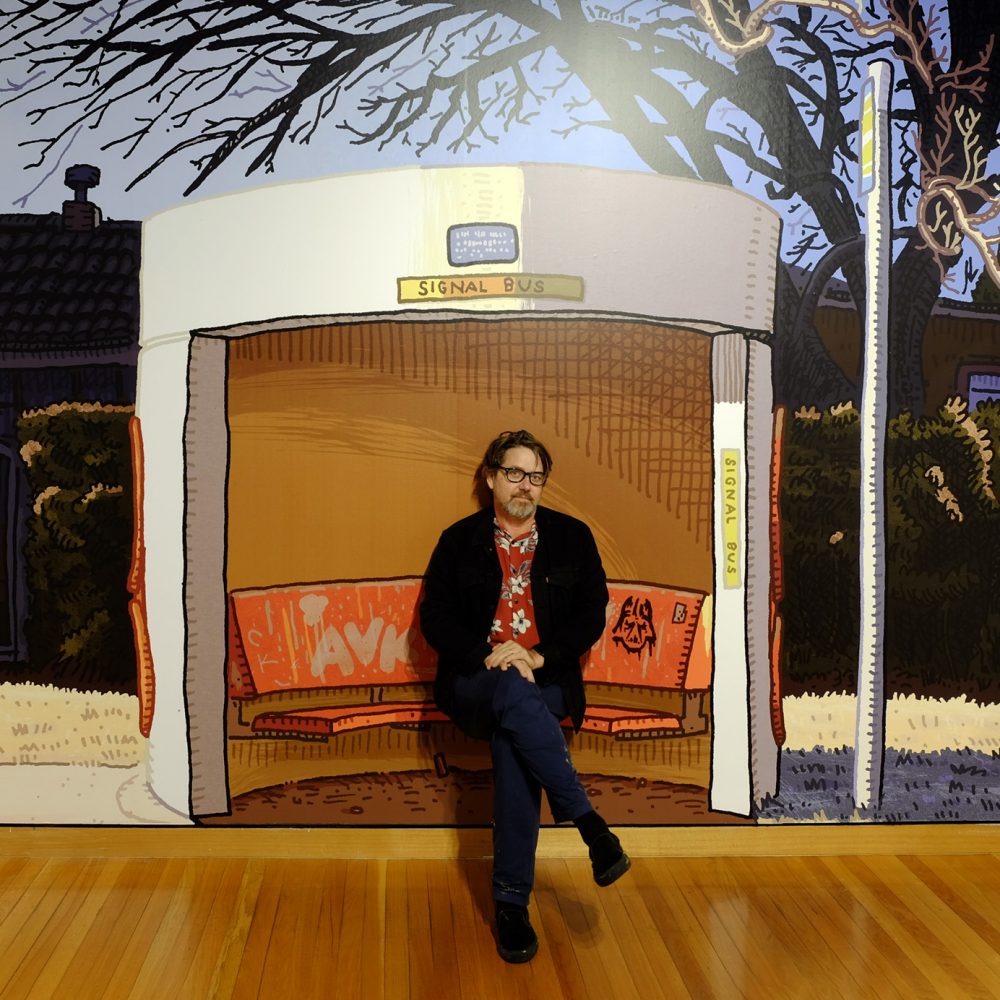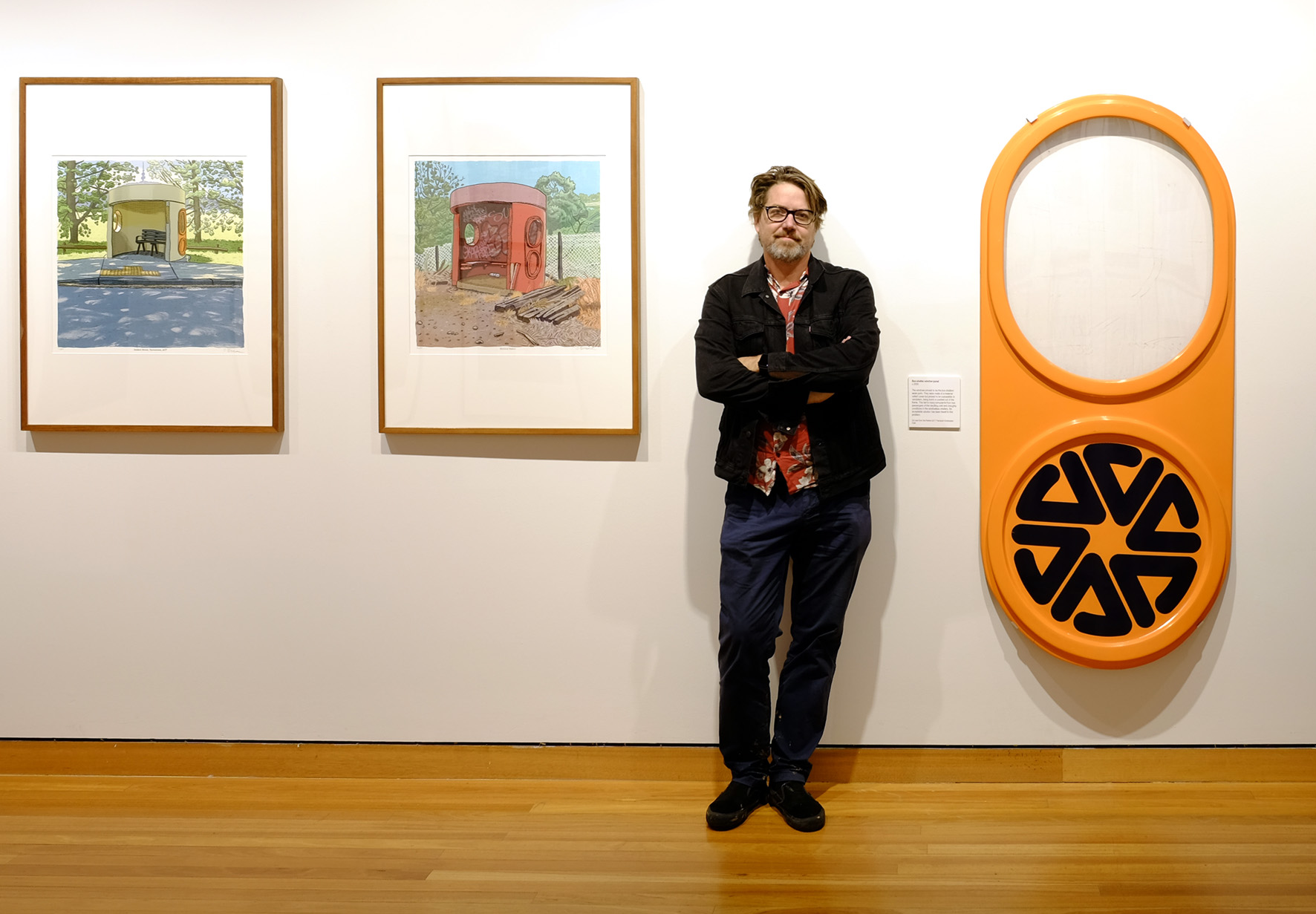
Trevor Dickinson: Beautiful Bus Shelters
Trevor Dickinson discusses Canberra’s beautiful bus shelters, featured in a recent exhibition at Canberra Museum and Art Gallery.
7 February, 2019
In Exhibitions,
Printmaking, Q&A
Imprint: Locals take the Canberra bus shelters for granted, but you obviously find great interest in them—can you describe how your interest developed and what it is about these pieces of architecture that interests you?
I first came to Canberra for a six-week residency at Megalo Print Studio. I was accepted based on a portfolio of work that I made in Newcastle. I was looking at the city as an outsider and trying to find locations and structures that felt different or foreign to my British background. A relevant example of this was a drawing series: one hundred letterboxes of Newcastle. While I viewed them as great examples of outsider art, most locals didn’t even notice them.
I wanted to use the same approach in Canberra. The concrete bus shelters were a natural subject as they seemed completely unique and, like the letterboxes, were not noticed as much by Canberrans due to familiarity. They are a great representation of 1970s style, with the added bonus of facial features to give them a sense of character.
The first few that I drew got a range of reactions from Canberrans; I heard how ugly they were and was told that there are one or two still around (483 actually). The best reactions were a feeling of ownership and memories that they aroused in viewers.
I began to realise that these bus shelters represented Canberra for Canberrans, in a way that a single building couldn’t. Taking on this project meant I would need to find and record every concrete bus shelter in the ACT before choosing the final selection to draw. It was going to be a long project and I needed some kind of outcome. So, I approached CMAG about an exhibition and they readily agreed.
Imprint: What is the general history of the shelters, and what of their future?
The shelters were designed by Canberra-based architect, Clem Cummings, and the first shelter was installed in Lyneham in 1975. They were manufactured in Melocco in Queanbeyan.
I’m always being told that the shelters are being got rid of, but the truth seems to be that they are just moved around as needed. The actual amount of them remains fairly constant. After over forty years, these shelters are too robust and functional to give up on.
Imprint: Can you describe some of the works and what visitors experienced in the exhibition?
The bus shelters are the link to all the pictures, but I see the exhibition as a portrait of a rarely represented Canberra. I was looking at the shelters in the context of their surroundings. Through the fifty-two prints, I have tried to cover all seasons, most weathers and times of day or night. There are urban shelters, rural shelters, shelters in the fog, early morning winter light, late evening sunset and night time under the street lamps.
I have drawn shelters from 46 different suburbs and each image represents an aspect of Canberra. All the pictures are square, and I spend a lot of time working on the composition and colour. I look closely at the relationships between the shelter and telegraph poles, trees, kerbs, bins, overhead wires, empty bottles, grafitti and other aspects of urban life.
Imprint: How was the work developed technically and what were some of the challenges involved?
For the shelters I had to work from my photographs because a lot of the views were from the middle of the road. I make a line drawing on paper, using either a graphic pen or ink pen, I scan this into the computer then colour the picture in photoshop, often bringing in painted or rough textures to add depth to the surface. My background is in screenprinting and I always try to avoid the image looking digital.
The most challenging aspect is to make the line drawing show depth and not feel like it’s just been ‘coloured in’. I do this by taking the lines apart and colouring them to bring forward the aspects I want to highlight or push back. Some pictures took over a week to finish.
I also find trees challenging, but I’m getting better.
Imprint: What future projects are you working on?
In January I’ll be starting a series of drawings in Taree for the Manning regional Gallery, NSW. The town seemed to have its heyday in the 1980s and there are plenty of faded examples of this period of architecture.
I also want to draw more in Newcastle as I have drawn Canberra for the past two years and I need a bit of time before I can see it with fresh eyes again.





